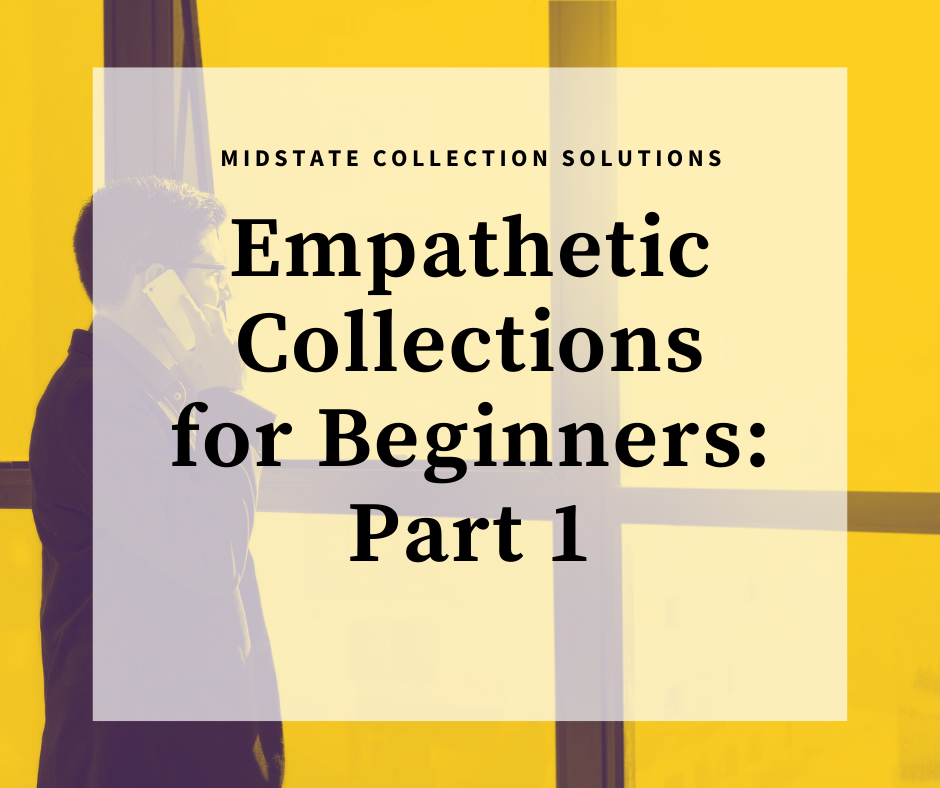Blog
Empathetic Collections for Beginners: Part 1

I’m excited to give you a 2-part series all about navigating empathetic collections.
Make sure to check back next week for part 2! For now, let’s dive into part 1, which is going to be about 3 types of empathy and when to use each one.
Oftentimes, I hear industry professionals explaining how important empathy truly is when it comes to collecting. And I wholeheartedly agree that empathy can boost your revenue and increase consistency on your collection floor.
Empathy can go beyond being a buzzword in the industry. Instead, it can be something we actively teach our team members.
When we don't implement empathy in our training programs, we run the risk of misunderstanding how to show empathy.
The truth is, each consumer has a unique experience or challenge, so the way we show empathy can change depending on what the consumer is going through.
In this week's blog, we're going to unpack 3 main types of empathy collectors can use in different scenarios.
If you stick with me, you'll have a better understanding of how to teach your collectors empathy and how to use empathy on the phone with consumers right away.
Back to the Basics
The first type of empathy I want to discuss is basic empathy because it can apply to most consumer stalls and objections.
When I say "basic empathy," I'm talking about the general definition of empathy, or what most people think about when they hear the word. It involves perspective-taking with the consumer to understand what they’re going through.
The best way to use perspective-taking on collection calls is to fully understand the consumer experience. When you understand what consumers are going through and what is causing their emotional reactions, it's much easier to reach a solution. Let me explain why...
When you display basic empathy, you’re verbally letting the consumer know that you hear them and you understand them so they can move on in the conversation and work toward a solution.
Pro Tip: If the consumer is telling a long story and can’t move on in the conversation, that’s a great time to use basic empathy. I actually wrote an entire blog post about this scenario, which you can read here.
One more thing: My latest online course, The Communication Code for Collectors, is all about how to communicate with basic empathy on challenging collection calls. If you want some actionable, effective tips for your common consumer stalls and objections, make sure to check out the course now.
Sharing the Wins with Consumers
If you’re familiar with my training, you know that I always encourage my students to share the wins with each other because it increases positivity and morale. You’ll be interested to know that you can also share the wins with consumers as a form of empathy. Let me explain what I mean.
Let’s say that instead of venting about a problem, a consumer shares something good with you. For example, maybe they got a new job. Just like when a consumer shares something negative, we can show empathy when they share something positive. And we can do this by letting the consumer know we appreciate that they've shared their wins with us.
Simply by saying, “That’s great news,” you’re showing the consumer that you’re excited for them, which will keep them engaged in the conversation and open to receiving any solutions you present.
Sharing the consumer's wins also allows you to keep a positive atmosphere on the collection floor, which will keep collectors motivated.
Appreciating Questions from Consumers
Another great way to show empathy is to be encouraging, specifically when a consumer asks a question.
Something you need to know is that asking a question can be difficult, and when we ask a question and don’t receive empathy in return, it can feel embarrassing, or we can feel uncomfortable. That’s why encouraging consumers when they ask a question is a great way to show empathy and move the call in a positive direction.
When a consumer asks you a question, you can show encouragement before you answer simply by saying, “That’s a great question.” That simple phrase can help a consumer feel relaxed, which will ultimately move the call forward toward the solution.
From Theory to Practice
Now that you know these 3 types of empathy, you can start using them on the phone with consumers right away and watch how effective empathetic communication can be.
If you want a step-by-step strategy to pair with what you’ve learned from this blog post, then The Communication Code for Collectors is a great resource to up-level your empathetic communication.
Do you want to use my strategies to train your entire team? Book a call with me today so we can discuss the details.
See this post as it was originally written on maryshores.com.